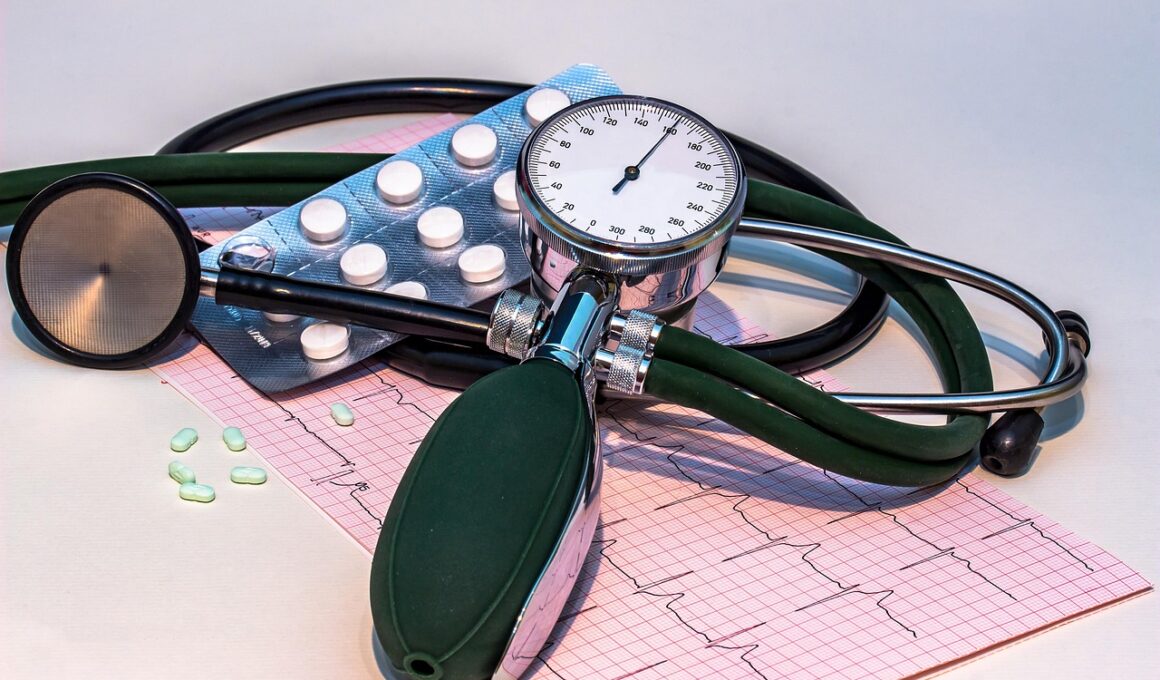The Role of HIIT in Improving Heart Rate Recovery
High-Intensity Interval Training (HIIT) has gained recognition in the fitness community for its effectiveness in enhancing cardiovascular fitness. This training method involves alternating short bursts of intense exercise with periods of lower-intensity recovery or rest. One of the significant benefits of HIIT is its impact on heart rate recovery (HRR). HRR is an essential indicator of cardiovascular health, reflecting how quickly your heart returns to its resting rate after exertion. Improved heart rate recovery indicates better cardiovascular function and reduces overall health risks. As you incorporate HIIT sessions into your routine, your body’s ability to recover efficiently is significantly enhanced, leading to improved athletic performance and general endurance. The short, intense nature of HIIT engages multiple muscle groups and challenges your heart, thus pushing your limits and helping to condition your cardiovascular system for better recovery. Participating in these high-intensity intervals exercises not only strengthens the heart itself but also improves circulation, which is vital for overall health. Moreover, HIIT can be adaptable to suit various fitness levels, making it accessible to a wide audience interested in optimizing their heart health.
Besides enhancing heart rate recovery, HIIT can provide other health benefits that positively affect your overall well-being. Research has shown that short bursts of intense activity can efficiently burn calories and promote fat loss, making HIIT an appealing workout choice in weight management plans. Furthermore, these workouts often take less time, making it easier to fit into busy schedules while still achieving maximum health benefits. This efficiency can boost motivation and adherence to exercise routines, particularly for those struggling to find the time for prolonged workouts. HIIT also helps to increase cardiac output and reduces resting heart rate, further contributing to improved heart health. Additionally, many HIIT sessions incorporate strength-training elements, which help increase lean muscle mass. Increasing your lean mass can further enhance your metabolism, aiding in weight loss and maintenance. It’s crucial to combine HIIT with a balanced diet to maximize its benefits, as nutrition plays a significant role in recovery and muscle building. Integrating a variety of activities, including strength moves, can keep HIIT exciting and prevent workout plateaus. Understanding the science behind HIIT enables participants to reap its full benefits for heart health.
How HIIT Affects Heart Rate Recovery
The physiological adaptations resulting from HIIT play a crucial role in improving heart rate recovery. During intense exercise, your heart beats rapidly to pump oxygenated blood to working muscles. This demands greater cardiovascular efficiency, prompting your heart to adapt over time. Consequently, with consistent training, your resting heart and exercise heart rates often reveal significant improvements. Your heart becomes more efficient in pumping blood, and, as a result, you observe a quicker return to resting heart rates post-exertion. This improvement is vital as it signifies reduced strain on the heart and a lower risk of cardiovascular diseases. When assessing HRR, it’s essential to note that individual factors such as age, fitness level, and underlying health conditions can influence your results. Nonetheless, incorporating HIIT has consistently shown encouraging results for enhancing HRR across various groups, regardless of age or baseline fitness. Thus, whether you are an athlete aiming for peak performance or someone attempting to improve fitness, HIIT is an effective solution to foster a healthier cardiovascular system. It’s necessary, however, to ensure a well-structured training plan to maximize benefits without overtraining or injury.
Individuals starting their HIIT journey often wonder how to structure their workouts effectively for optimal heart rate recovery improvements. Creating appropriate intervals is crucial; typically, sessions consist of intense bursts lasting from 20 seconds to a few minutes, followed by brief recovery periods. Studies suggest a ratio of 1:1 or 2:1 for work-to-rest intervals, which can be altered based on fitness levels. For example, if you perform 30 seconds of sprinting, you can rest for 30 seconds to a minute before repeating. Beginners should start with shorter and less intense intervals, progressively increasing duration and intensity as fitness improves. Moreover, adding variety to your HIIT sessions can help prevent boredom and stimulate further adaptation. Consider incorporating various exercises such as burpees, sprints, jump rope, or cycling to keep the workouts engaging. Tracking your heart rate during workouts is also beneficial; using a heart rate monitor can provide real-time feedback, helping you stay within target zones for optimal performance. As your fitness progresses, you’ll notice improvements not only in HRR but overall cardiovascular endurance and health, making HIIT a worthwhile addition to your fitness regime.
Incorporating HIIT into a Routine
To truly maximize the benefits of HIIT for heart rate recovery, proper incorporation into your weekly routine is important. However, it’s not solely about the frequency of workouts but also about ensuring adequate recovery between sessions. Most fitness experts recommend engaging in HIIT training two to three times per week. This allows for maximum recovery time between sessions, which is essential for repairing muscles and strengthening the cardiovascular system. Balancing HIIT with lower-intensity training, such as steady-state cardio or strength training, provides a comprehensive approach that benefits overall fitness. This balance can prevent burnout, enhance recovery, and improve heart rate recovery gradually. Additionally, flexibility in workout scheduling can aid adherence and maintain motivation, as workouts rarely feel monotonous when different intervals are introduced each time. Moreover, proper nutrition and hydration are fundamental aspects of recovery; incorporating nutritious foods and adequate hydration can positively influence your performance. With dedication and consistency, individuals at all fitness levels can experience enhanced cardiovascular benefits and improved heart rate recovery. Finally, tracking and celebrating personal progress within your HIIT journey can help maintain a positive mindset and motivation throughout your fitness pathway.
As with any physical activity, safety is a primary concern when engaging in HIIT. Understanding the potential risks and precautions is crucial for individuals looking to improve their heart rate recovery safely. Before starting a HIIT program, it’s advisable to consult a healthcare professional, particularly if you have pre-existing conditions or concerns about your heart health. Proper warm-up and cool-down sessions are equally important; they prepare your body for intense exertion and help minimize the risks of injury. During workouts, listen to your body—if you experience dizziness, sharp pain, or excessive fatigue, stop immediately and assess your condition. Additionally, incorporating rest days into your routine is essential to avoid overtraining, as this may negatively impact performance and recovery. Ensuring that you perform exercises with the correct form will reduce the chance of injury while maximizing effectiveness. Investing in a quality pair of shoes designed for high-intensity training can also safeguard joint health. Lastly, understanding your limits and gradually increasing the intensity of your workouts can lead to safe and effective progress. Emphasizing safety will enable participants to fully enjoy the comprehensive benefits HIIT provides for heart health.
Conclusion: Embracing HIIT for Heart Health
In summary, implementing High-Intensity Interval Training can significantly improve heart rate recovery, enhancing overall cardiovascular fitness. The adaptability of HIIT allows individuals across various fitness levels to participate effectively, promoting better health outcomes. As you become more familiar with HIIT’s principles, you’ll find that it not only helps with heart rate recovery but also inspires adherent long-term healthy habits. With clearly defined structure, recovery protocols, and thoughtful integrations into your routine, the potential health benefits escalate. Participants often report increased energy levels and improved mental well-being; consistent HIIT can contribute positively to physical and mental health alike. As you embark on your journey with HIIT, be mindful of progression, safety, and enjoyment, as these factors greatly enhance compliance. As you become stronger, faster, and increasingly fit, the rewards, both in terms of heart health and overall fitness levels, will be evident. By committing to regular training and focusing on mindful recovery, the path toward a healthier heart becomes not just achievable but enjoyable. Embrace HIIT as a powerful ally in your cardiovascular health, maintenance, and improvement journey today.
Overall, HIIT offers a myriad of benefits that go beyond just improved heart rate recovery. Commit to recognizing its transformative potential for a healthier lifestyle. Whether you’re looking to enhance your athletic performance or simply maintain a healthy heart, HIIT practices can guide you through your fitness journey. The engagement and challenge presented by HIIT can propel your cardiovascular fitness to new heights, fostering improvements that might have previously felt unreachable. In cultivating consistency and enjoyment in these workouts, you foster an environment that promotes lifelong health and wellness. Find supportive communities, resources, and programs that can enrich your HIIT experience, allowing you to tailor it to fit your lifestyle. Your journey with HIIT should feel rewarding and empowering, evolving as your fitness does. As you focus on recovery between sessions, prioritize your nutritional and hydration needs, and celebrate achievements, you will optimize your health outcomes. Make a commitment to pushing your limits safely; the path to better heart health begins with informed decisions and perseverance. HIIT is not just an exercise program; it represents a holistic approach to improving your cardiovascular health, offering a fulfilling path to a vibrant and healthy life.


